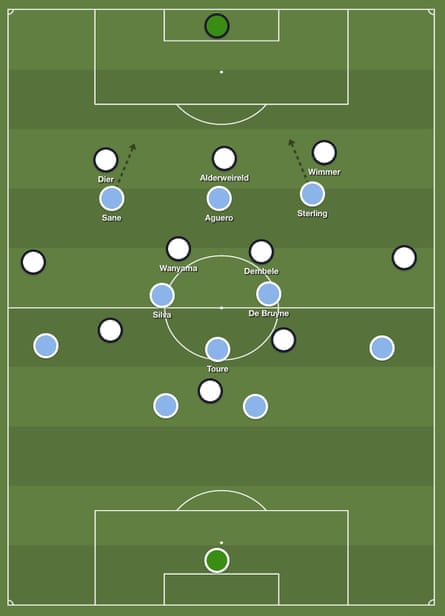There are many similarities between the footballing philosophies of Pep Guardiola and Mauricio Pochettino, and for the second time this season, Manchester City and Tottenham Hotspur contested a fast-paced, exciting game based around pressing and high defensive lines. Whereas Tottenham ran out 2-0 winners in October, however, City failed to translate their superiority here into three points.
Guardiola has often played a 4-2-3-1 in recent weeks but on Saturday used a 4-3-3 – and an extremely attack-minded 4-3-3 at that. Leroy Sané, Sergio Agüero and Raheem Sterling played high up the pitch, pressing Tottenham’s centre-backs, while David Silva and Kevin De Bruyne returned to the deeper roles they played at the start of the campaign, with Yaya Touré deployed on his own in the holding role. This might have been disastrous – Touré’s tactical discipline has rightly been questioned in recent years – but Silva and De Bruyne demonstrated wonderful skill and composure in possession to ease past Tottenham’s midfield press, and put City in charge.
In a game between two sides using high defensive lines, runs in behind the opposition were always likely to be crucial. Sterling was the first man to break through, when running on to one of De Bruyne’s countless superb penetrative passes, although Sterling’s inability to actually get a shot away, when it had briefly appeared a one-on-one opportunity, summarised Manchester City’s frustrating lack of killer instinct. That’s been a problem throughout the season but in last weekend’s 4-0 defeat by Everton and the first half here it has reached new heights.
Tottenham’s defensive play was unusually poor here, with gaps between the three centre-backs so inviting that even the City right-back Pablo Zabaleta charged through on goal at one point. Toby Alderweireld produced an outstanding, if desperate, last-man challenge to deny him, while Danny Rose’s tackle on Sterling was even better. However, Spurs were relying on last-ditch defending far too much, which convinced Pochettino to change shape dramatically.

Having started with a three-man defence, his default shape in recent weeks, Pochettino switched to a 4-2-3-1. Eric Dier moved forward from centre-back to central midfield, with Mousa Dembélé going to the top of the triangle. This initially worked effectively, as Tottenham got numbers into midfield and finally had a spell of possession, while Rose and Kyle Walker retreated into defence, and Tottenham had four against three to provide support against City’s three forwards. This move stabilised the game and stopped City’s onslaught, although the combination of Dier and Victor Wanyama in midfield was hardly the most creative and Tottenham created little.
That lack of guile in midfield, combined with Kevin Wimmer’s poor first-half performance, meant Pochettino made a substitution at half-time, with Son Heung-min replacing Wimmer. Dier returned to defence, Dembélé dropped into a deeper midfield role again and now Spurs were using the XI Pochettino would have named had he started with a four-man defence.
They looked considerably more comfortable in that system – but now, surprisingly, City struck. Yet another of De Bruyne’s balls in behind found Sané racing through and after Hugo Lloris’s disastrous attempt at a sweeping, headed clearance only sent the ball against Sané, the City winger tapped into an empty net. Another inexplicable Lloris mistake gave De Bruyne, the game’s outstanding player, a tap-in to make it 2-0. It was seemingly game over.
Tottenham’s resilience was hugely impressive, however. Dele Alli made a good late run into the box for what is fast becoming his trademark goal, pulling Spurs back into the game. The departure of Alderweireld, arguably the Premier League’s best defender this season, might have been catastrophic but somehow this worked out brilliantly for Tottenham – it forced Pochettino to introduce the midfielder Harry Winks, with Wanyama switched to centre-back alongside Dier. Spurs’ previous midfield partnership was now their centre-back partnership. Winks demonstrated remarkable composure in possession, not misplacing any of his 13 passes, and Tottenham built a spell of genuine pressure for the first time. Son’s equaliser was not entirely unexpected.
The post-match talking point was Walker’s blatant, unpunished push on Sterling, with the City winger through on goal 15 minutes from time from an Aleksandar Kolarov through ball. In a game between two teams using such high defensive lines, through balls and speed in behind were always likely to produce major incidents.
Guardiola will be more concerned, however, about Manchester City’s poor performance in the penalty boxes. Here they recorded 17 shots to Tottenham’s six, seven on target compared to Tottenham’s two. Claudio Bravo was not at fault for the two goals but he again did not make a single save, while at the other end Sterling’s lack of end product once more underlined City’s profligacy.
Guardiola’s emphasis upon technical ball-players has its benefits but merely dominating matches, rather than actually winning them, is plainly not enough.